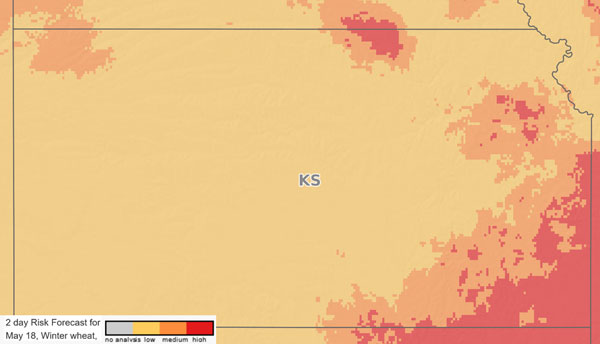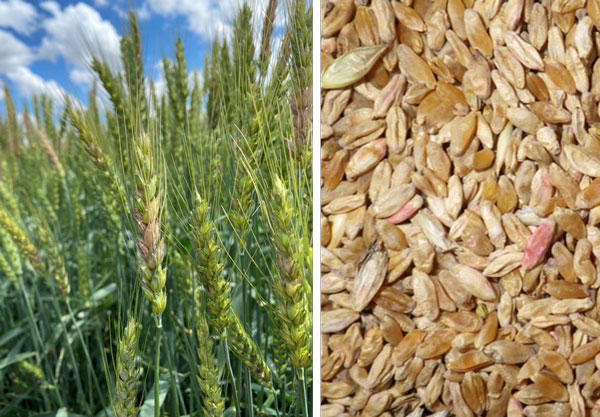Wet weather has been creeping into northeast Kansas this week resulting in conditions favorable for Fusarium head blight (scab). In this article, we walk through some reminders for fungicide applications for each of these diseases.
The 48-hour forecast looks favorable for scab development in eastern parts of the state as well as isolated parts of north central and northwest Kansas according to wheatscab.psu.edu (Figure 1). The highest risk will be in fields of scab-susceptible varieties at the flowering growth stage during this wet weather. Fields with a previous history of scab or with corn residue and a yield potential above 40 bu/a should be prioritized for a fungicide application. For a reminder about the scab ratings for individual varieties, please refer to the Kansas Wheat Variety Guide: https://bookstore.ksre.ksu.edu/pubs/mf991.pdf.

Figure 1. Fusarium head blight (scab) risk including forecasted weather for 48 hours after May 18, 2023. Red areas indicate regions with the most favorable forecasted weather, yellow indicates low risk. This model is calibrated for susceptible varieties of winter wheat. This interactive map can be accessed at www.wheatscab.psu.edu.
Scab infection occurs at flowering, but symptoms are often not visible for 14-21 days after infection (Figure 2). Because of this, we cannot scout for scab the way we would stripe rust or other foliar diseases. Fungicide decisions need to be made according to the weather-based risk and the field’s yield potential. Not only can scab lower yield and test weights, it also produces a mycotoxin (vomitoxin, DON) that can lead to discounts or rejections at elevators.

Figure 2. Fusairum head blight (scab) infection often begins with bleaching of infected spikelets and will progress throughout the head. When humidity is high, orange fungal structures are visible on the outside of the spikelet. Grain from infected heads may appear lightweight, white, or pink. Photos by: K-State Research and Extension.
Reminders for scab fungicide applications
Fungicide products
Fungicides such as Prosaro, Sphearex, Prosaro Pro, Proline, or Miravis Ace are known to suppress scab (head blight). Specific fungicide performance for scab and other diseases can be found here: https://bookstore.ksre.ksu.edu/pubs/EP130.pdf. Other fungicides are not labeled or not recommended for scab control, particularly products containing strobilurin (FRAC group 11 – azoxystrobin, pyraclostrobin, etc.)
Timing
Fungicides are most effective against scab when applied at early flowering (Feekes 10.5.1) but can provide protection even when applied later in the flowering window. It is important to pay attention to pre-harvest intervals at this point of the season and follow guidelines provided on product labels. The products listed above either have a 30-day pre-harvest interval (cannot be applied within 30 days of harvest) or cannot be applied after Feekes 10.5.4 (end of flowering, watery ripe growth stage).
It is important to remember that early flag-leaf fungicide applications will have little to no effect on scab.
Rainfastness
With the current, wet weather, we are getting many questions about fungicide rainfastness. Rainfast time is defined as the period of time that needs to pass between the application of a fungicide and a rainfall event where the fungicide will not lose efficacy. This information is often not included on the product label or is ambiguous. Rainfast time will be variable with temperature and canopy moisture, but most products recommended for wheat in Kansas will be rainfast within two hours, and likely within one hour under most conditions. Rainfastness is improved when a product is applied with a non-ionic surfactant (NIS).
Residual life
The residual life of the fungicide application is influenced by the product used, environment, and rate of application. In general, products belonging to the triazole and strobilurin classes of fungicide will run out of gas (you may start to see symptoms) after 21 days (about 3 weeks). Small differences in residual life among products typically do not result in large differences in grain yield. Some newer products are promoted as having much longer residual lives, but we don’t have university research that supports those claims.
A vast majority of the labeled fungicides for wheat in Kansas will not provide protection for new growth (only leaves present at the time of application are protected).
Seed treatments
Seed treatments do not have any influence on disease development during the growing season, as the fungicides in these seed treatments wear off within 30-45 days. Seed treatments can improve the emergence of seed from infected fields as this pathogen can cause seedling diseases when infected seed is planted back.
Kelsey Andersen Onofre, Extension Wheat Pathologist
andersenk@ksu.edu
Tags: disease wheat fusarium head blight thin wheat wheat scab scab